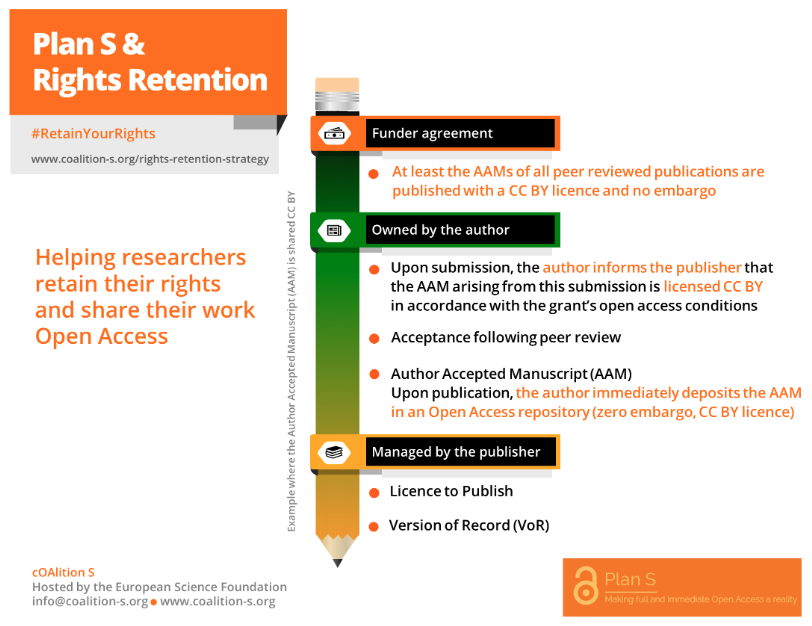Open Access Week 2025, Day 2: Asserting your rights
By Katherine Hughes, EMBL Open Science Information Specialist
Welcome to Day 2 of The 5 Days of Open Access Week!
For Open Access Week 2025, OSIM will release a blog post each day on a different topic with a short quiz or activity. Complete each activity, and you will be entered in a raffle to win a prize.
Day 1’s post focused on the different open access (OA) business models centred around gold open access (OA). A significant obstacle to publishing the Version of Record OA is that it costs a considerable amount of money. Many academics, particularly those from low- and middle- income regions as well as early career researchers don’t have the funds to pay to have their work published OA. If authors can’t pay to publish OA, then their article is placed behind a paywall. It is estimated that roughly 75% of the world’s research is behind a paywall and controlled by commercial companies.
In a recent article, Abeer Fatima asserts “Paywalls, once accepted as part of the traditional publishing model, are now being recognized as one of the biggest obstacles to global research equity. The consequences are not just academic. They shape who participates in science, who gets cited, and who is left out.”
These companies would not own the knowledge if authors did not sign it over to them.
When an author agrees to publish an article behind a paywall, they are required to sign a Copyright Transfer Agreement (CTA). A CTA not only provides the publishers with a license to publish and disseminate an author’s work, it also transfers copyright to the publisher. The author no longer has access to their own work unless they pay for it, nor do they have a say in how it is disseminated including use in AI.
Publishing behind a paywall slows the progress of science. Many funders, governments, and institutions responded by requiring that research partially or wholly supported with their money must be made OA immediately upon publication (free to read) and with a CC BY license (free to re-use). When an author is required to sign a CTA and publish the paper behind a paywall it places them in breach of their funding or employment contracts.
Even archiving (green OA) the Author Accepted Manuscript (AAM), traditionally thought to belong to the author, was restricted by an embargo period that could last from 6 months to 18 months. In 2020, cOAlition S, a consortium of international funders, introduced Plan S (the ‘S’ stands for Shock) which includes a Rights Retention Strategy (RRS). The goal of the RRS was to allow authors to assert their copyright over the AAM and deposit it in a repository with a CC BY license immediately upon publication.

Rights Retention is based on the simple principle that authors and institutions should retain rights to their own research. RRS is not new, Harvard introduced a Scholarly Communication Licence in 2008 after faculty unanimously voted to deposit a copy of their work in Harvard’s institutional repository. Since then, many more institutions have implemented an institutional RRS. On 1 July 2025, EMBL updated its Open Science Policy (IP71) establishing an institutional RRS on research articles submitted to a journal on or after that date.
There are several benefits of Rights Retention for authors:
- Allows authors to freely share their work while maintaining academic freedom
- All of EMBL’s research will be available upon publication (therefore no delays) under a Creative Commons Attribution (CC-BY) licence.
- Work will be made freely available regardless of the availability of funding
- It ensures that all researchers are compliant with funder requirements and EMBL’s Open Science policy
By implementing a RRS, authors now have three routes to publication.
1) Publish the article open access with a CC-BY licence in a fully open access journal.
2) Publish the article open access with a CC-BY licence in a hybrid journal that is part of a transformative agreement that EMBL currently participates in. A list of these agreements can be found on the Szilárd Library website.
3) Publish the article behind a paywall and have the AAM deposited with a CC BY licence into Europe PMC at the time of publication, with no embargo.
What researchers need to do?
On submission: In order to convey the EMBL’s Rights Retention Policy, publishers have been formally notified in advance by email and letter. For additional transparency, or where a funder requires it, authors can include the following statement in the acknowledgement section and cover letter of their article submission:
“For the purpose of Open Access, a CC-BY public copyright licence has been applied to the present document and will be applied to all subsequent versions up to the Author Accepted Manuscript arising from this submission.”
On acceptance: Contact OSIM and the team will deposit the AAM on the author’s behalf with a Creative Commons Attribution licence (CC BY) in Europe PMC without an embargo.
Where to go for support
If you have any questions or need advice on any aspects of this policy and open research practices, please email osim@embl.org.
Complete the quiz to test your knowledge of open access (and for a chance to win a prize).